Detecting System Errors in Virtual Reality Using EEG Through Error-Related Potentials
PubDate: May 2020
Teams: Graz University of Technology;University of Lisbon;Inria, Univ. Rennes;Univ. Toulouse;University of Essex
Writers: Hakim Si-Mohammed; Catarina Lopes-Dias; Maria Duarte; Ferran Argelaguet; Camille Jeunet; Géry Casiez; Gernot R Müller-Putz;Anatole Lécuyer;Reinhold Scherer
PDF: Detecting System Errors in Virtual Reality Using EEG Through Error-Related Potentials

Abstract
When persons interact with the environment and experience or witness an error (e.g. an unexpected event), a specific brain pattern, known as error-related potential (ErrP) can be observed in the electroencephalographic signals (EEG). Virtual Reality (VR) technology enables users to interact with computer-generated simulated environments and to provide multi-modal sensory feedback. Using VR systems can, however, be error-prone. In this paper, we investigate the presence of ErrPs when Virtual Reality users face 3 types of visualization errors: (Te) tracking errors when manipulating virtual objects, (Fe) feedback errors, and (Be) background anomalies. We conducted an experiment in which 15 participants were exposed to the 3 types of errors while performing a center-out pick and place task in virtual reality. The results showed that tracking errors generate error-related potentials, the other types of errors did not generate such discernible patterns. In addition, we show that it is possible to detect the ErrPs generated by tracking losses in single trial, with an accuracy of 85%. This constitutes a first step towards the automatic detection of error-related potentials in VR applications, paving the way to the design of adaptive and self-corrective VR/AR applications by exploiting information directly from the user’s brain.


